Disruptive Innovation Network: Strategies and Business Impact Analysis
VerifiedAdded on 2020/05/11
|11
|2423
|92
Report
AI Summary
This report provides a comprehensive overview of disruptive innovation, exploring its core concepts and practical applications within the business landscape. It begins by defining disruptive technology and innovation, contrasting it with sustaining innovation and explaining how disruptive technologies create new markets and values, ultimately reshaping existing ones. The report delves into the objective and scope of understanding disruptive innovation's contribution to business, acknowledging its significance for both established and emerging companies. It then reviews relevant literature, examining the 'dilemma of the innovator' and the three essential elements of disruption, as well as the distinction between sustaining and disruptive innovation. The report also uses the example of Minimills in the steel industry to illustrate disruptive innovation in action, highlighting how new entrants can challenge established players. The conclusion emphasizes the ongoing evolution of disruptive innovation theory, the challenges of implementing it, and the importance of understanding its complexities for business success. The report underscores the value of using this theory to predict business trends and make informed decisions.
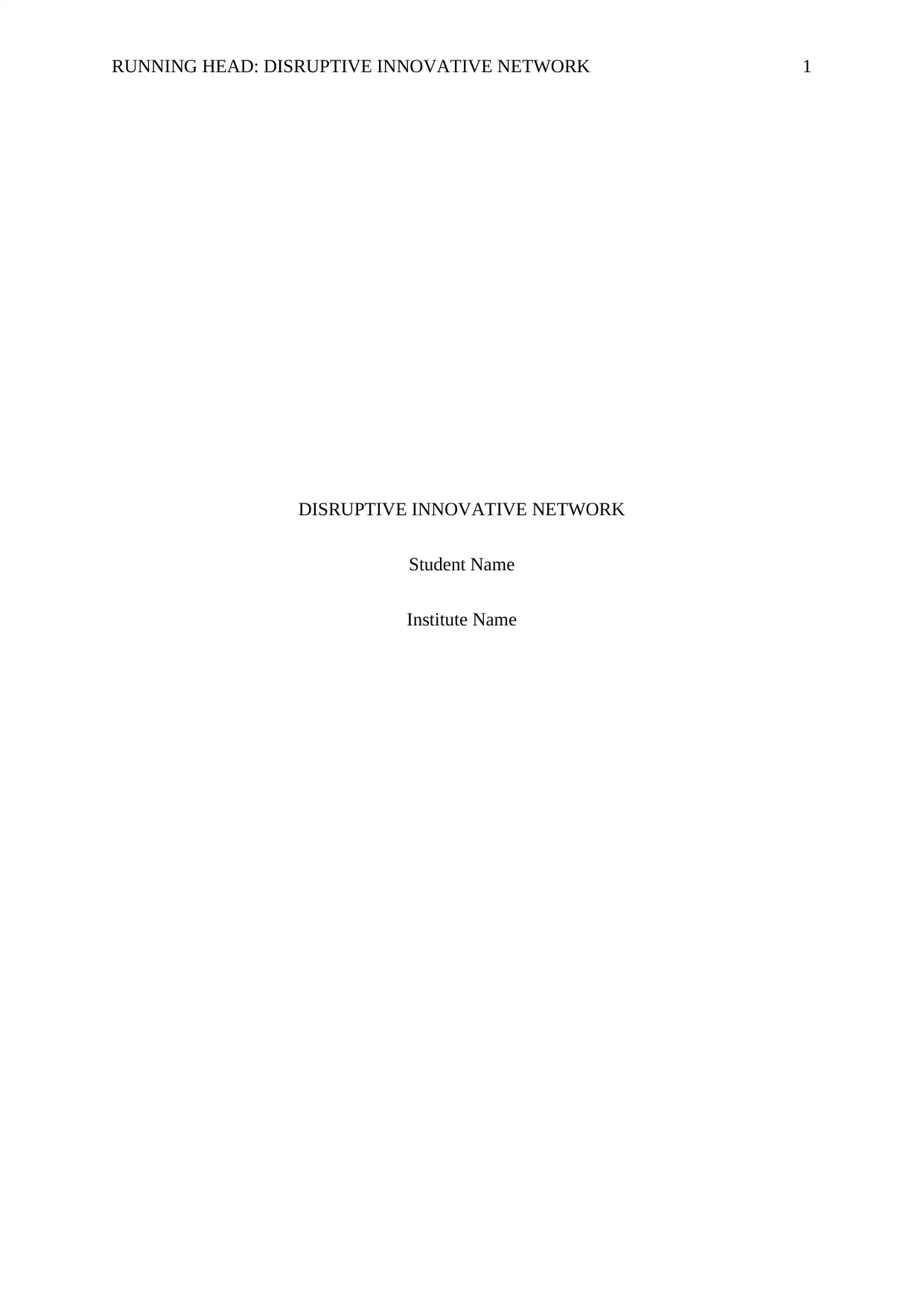
RUNNING HEAD: DISRUPTIVE INNOVATIVE NETWORK 1
DISRUPTIVE INNOVATIVE NETWORK
Student Name
Institute Name
DISRUPTIVE INNOVATIVE NETWORK
Student Name
Institute Name
Paraphrase This Document
Need a fresh take? Get an instant paraphrase of this document with our AI Paraphraser
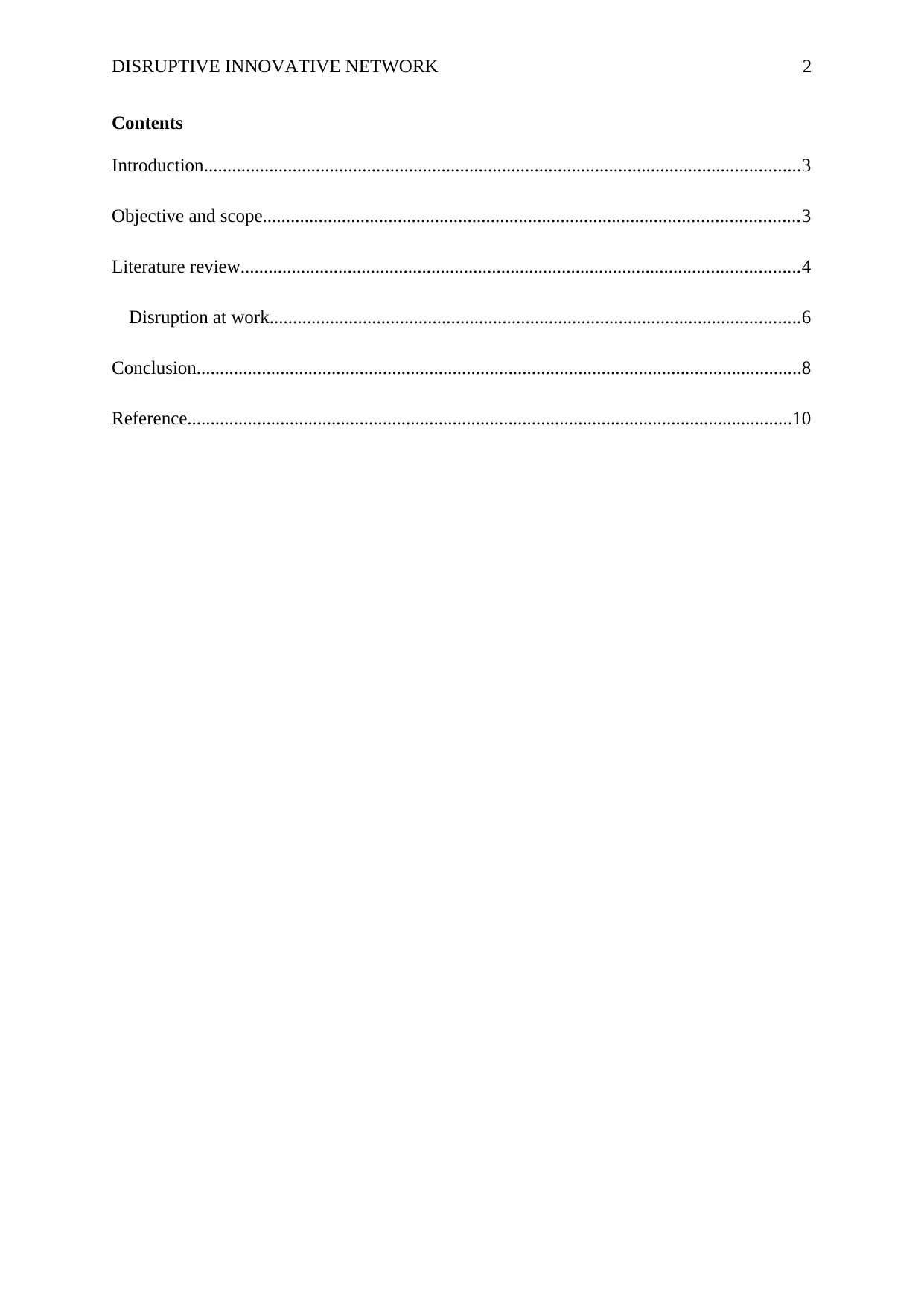
DISRUPTIVE INNOVATIVE NETWORK 2
Contents
Introduction................................................................................................................................3
Objective and scope...................................................................................................................3
Literature review........................................................................................................................4
Disruption at work..................................................................................................................6
Conclusion..................................................................................................................................8
Reference..................................................................................................................................10
Contents
Introduction................................................................................................................................3
Objective and scope...................................................................................................................3
Literature review........................................................................................................................4
Disruption at work..................................................................................................................6
Conclusion..................................................................................................................................8
Reference..................................................................................................................................10
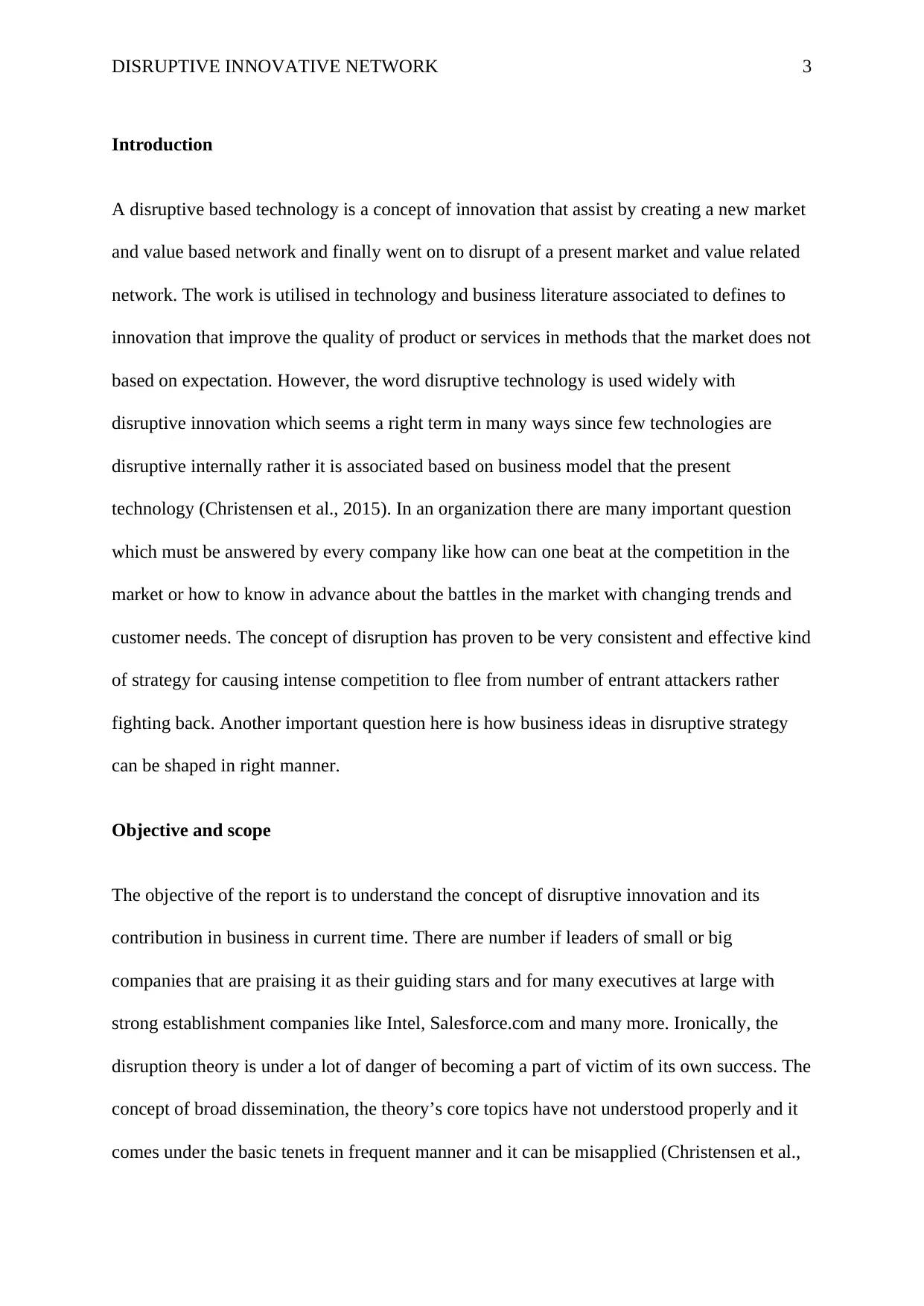
DISRUPTIVE INNOVATIVE NETWORK 3
Introduction
A disruptive based technology is a concept of innovation that assist by creating a new market
and value based network and finally went on to disrupt of a present market and value related
network. The work is utilised in technology and business literature associated to defines to
innovation that improve the quality of product or services in methods that the market does not
based on expectation. However, the word disruptive technology is used widely with
disruptive innovation which seems a right term in many ways since few technologies are
disruptive internally rather it is associated based on business model that the present
technology (Christensen et al., 2015). In an organization there are many important question
which must be answered by every company like how can one beat at the competition in the
market or how to know in advance about the battles in the market with changing trends and
customer needs. The concept of disruption has proven to be very consistent and effective kind
of strategy for causing intense competition to flee from number of entrant attackers rather
fighting back. Another important question here is how business ideas in disruptive strategy
can be shaped in right manner.
Objective and scope
The objective of the report is to understand the concept of disruptive innovation and its
contribution in business in current time. There are number if leaders of small or big
companies that are praising it as their guiding stars and for many executives at large with
strong establishment companies like Intel, Salesforce.com and many more. Ironically, the
disruption theory is under a lot of danger of becoming a part of victim of its own success. The
concept of broad dissemination, the theory’s core topics have not understood properly and it
comes under the basic tenets in frequent manner and it can be misapplied (Christensen et al.,
Introduction
A disruptive based technology is a concept of innovation that assist by creating a new market
and value based network and finally went on to disrupt of a present market and value related
network. The work is utilised in technology and business literature associated to defines to
innovation that improve the quality of product or services in methods that the market does not
based on expectation. However, the word disruptive technology is used widely with
disruptive innovation which seems a right term in many ways since few technologies are
disruptive internally rather it is associated based on business model that the present
technology (Christensen et al., 2015). In an organization there are many important question
which must be answered by every company like how can one beat at the competition in the
market or how to know in advance about the battles in the market with changing trends and
customer needs. The concept of disruption has proven to be very consistent and effective kind
of strategy for causing intense competition to flee from number of entrant attackers rather
fighting back. Another important question here is how business ideas in disruptive strategy
can be shaped in right manner.
Objective and scope
The objective of the report is to understand the concept of disruptive innovation and its
contribution in business in current time. There are number if leaders of small or big
companies that are praising it as their guiding stars and for many executives at large with
strong establishment companies like Intel, Salesforce.com and many more. Ironically, the
disruption theory is under a lot of danger of becoming a part of victim of its own success. The
concept of broad dissemination, the theory’s core topics have not understood properly and it
comes under the basic tenets in frequent manner and it can be misapplied (Christensen et al.,
⊘ This is a preview!⊘
Do you want full access?
Subscribe today to unlock all pages.

Trusted by 1+ million students worldwide
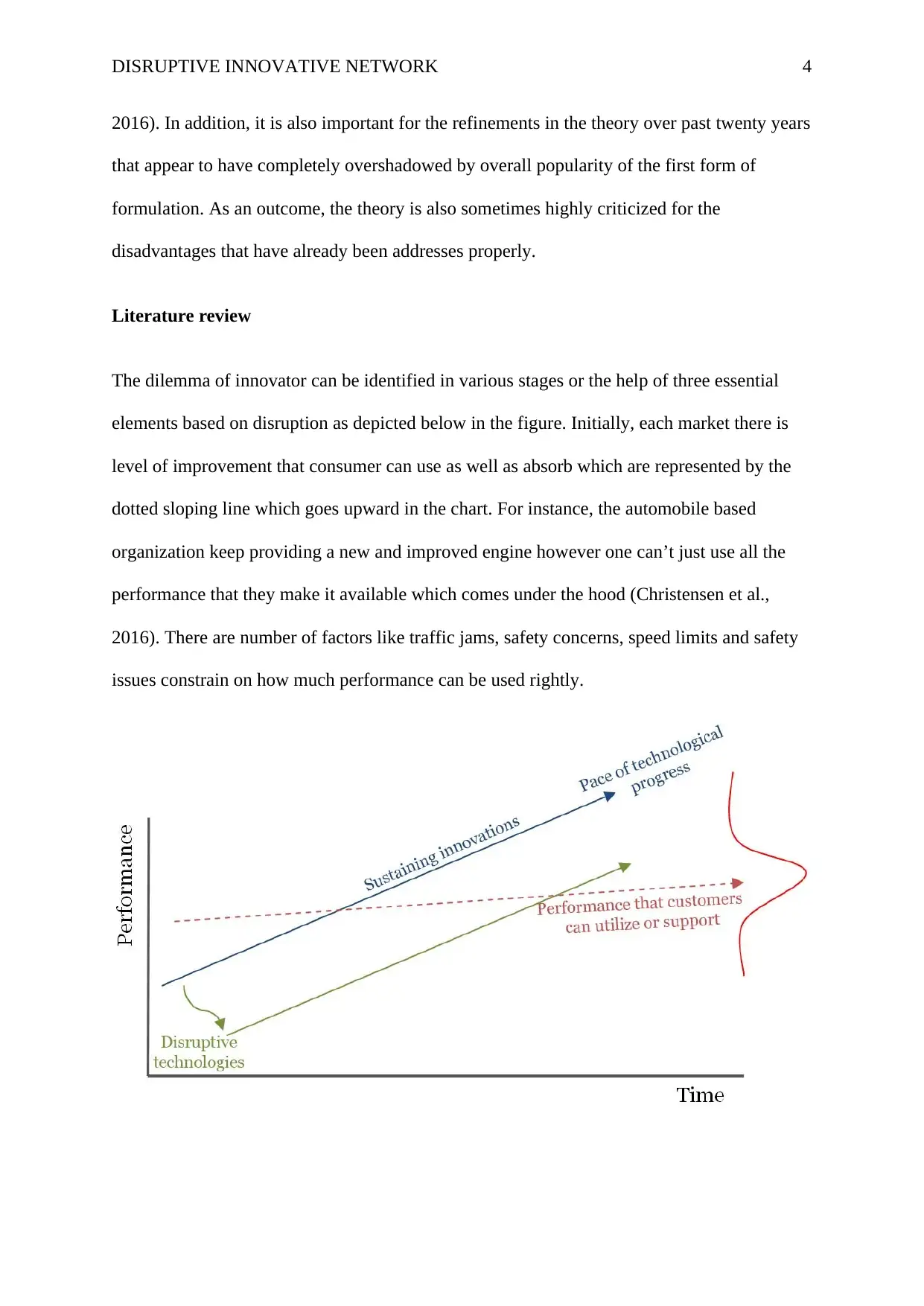
DISRUPTIVE INNOVATIVE NETWORK 4
2016). In addition, it is also important for the refinements in the theory over past twenty years
that appear to have completely overshadowed by overall popularity of the first form of
formulation. As an outcome, the theory is also sometimes highly criticized for the
disadvantages that have already been addresses properly.
Literature review
The dilemma of innovator can be identified in various stages or the help of three essential
elements based on disruption as depicted below in the figure. Initially, each market there is
level of improvement that consumer can use as well as absorb which are represented by the
dotted sloping line which goes upward in the chart. For instance, the automobile based
organization keep providing a new and improved engine however one can’t just use all the
performance that they make it available which comes under the hood (Christensen et al.,
2016). There are number of factors like traffic jams, safety concerns, speed limits and safety
issues constrain on how much performance can be used rightly.
2016). In addition, it is also important for the refinements in the theory over past twenty years
that appear to have completely overshadowed by overall popularity of the first form of
formulation. As an outcome, the theory is also sometimes highly criticized for the
disadvantages that have already been addresses properly.
Literature review
The dilemma of innovator can be identified in various stages or the help of three essential
elements based on disruption as depicted below in the figure. Initially, each market there is
level of improvement that consumer can use as well as absorb which are represented by the
dotted sloping line which goes upward in the chart. For instance, the automobile based
organization keep providing a new and improved engine however one can’t just use all the
performance that they make it available which comes under the hood (Christensen et al.,
2016). There are number of factors like traffic jams, safety concerns, speed limits and safety
issues constrain on how much performance can be used rightly.
Paraphrase This Document
Need a fresh take? Get an instant paraphrase of this document with our AI Paraphraser
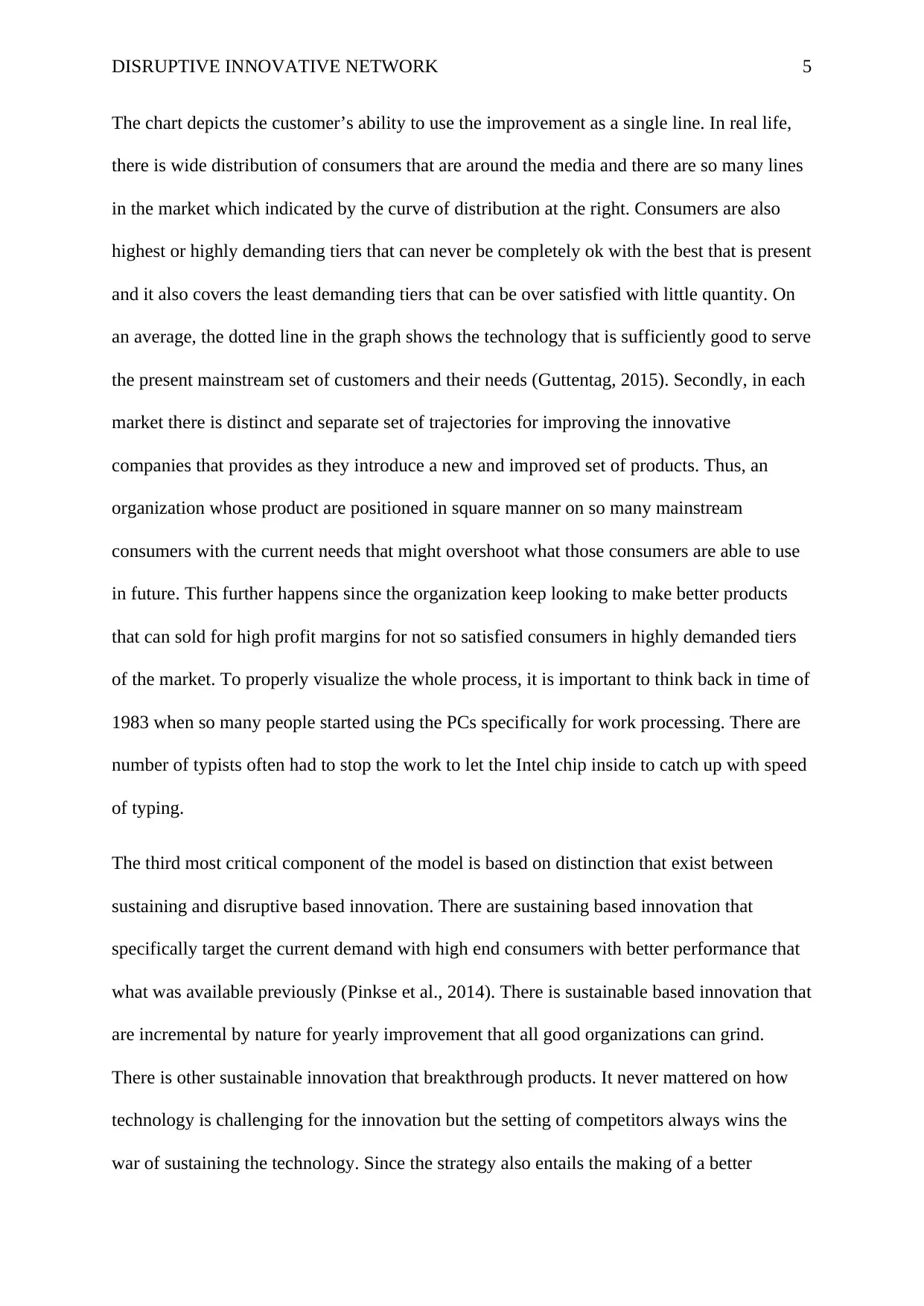
DISRUPTIVE INNOVATIVE NETWORK 5
The chart depicts the customer’s ability to use the improvement as a single line. In real life,
there is wide distribution of consumers that are around the media and there are so many lines
in the market which indicated by the curve of distribution at the right. Consumers are also
highest or highly demanding tiers that can never be completely ok with the best that is present
and it also covers the least demanding tiers that can be over satisfied with little quantity. On
an average, the dotted line in the graph shows the technology that is sufficiently good to serve
the present mainstream set of customers and their needs (Guttentag, 2015). Secondly, in each
market there is distinct and separate set of trajectories for improving the innovative
companies that provides as they introduce a new and improved set of products. Thus, an
organization whose product are positioned in square manner on so many mainstream
consumers with the current needs that might overshoot what those consumers are able to use
in future. This further happens since the organization keep looking to make better products
that can sold for high profit margins for not so satisfied consumers in highly demanded tiers
of the market. To properly visualize the whole process, it is important to think back in time of
1983 when so many people started using the PCs specifically for work processing. There are
number of typists often had to stop the work to let the Intel chip inside to catch up with speed
of typing.
The third most critical component of the model is based on distinction that exist between
sustaining and disruptive based innovation. There are sustaining based innovation that
specifically target the current demand with high end consumers with better performance that
what was available previously (Pinkse et al., 2014). There is sustainable based innovation that
are incremental by nature for yearly improvement that all good organizations can grind.
There is other sustainable innovation that breakthrough products. It never mattered on how
technology is challenging for the innovation but the setting of competitors always wins the
war of sustaining the technology. Since the strategy also entails the making of a better
The chart depicts the customer’s ability to use the improvement as a single line. In real life,
there is wide distribution of consumers that are around the media and there are so many lines
in the market which indicated by the curve of distribution at the right. Consumers are also
highest or highly demanding tiers that can never be completely ok with the best that is present
and it also covers the least demanding tiers that can be over satisfied with little quantity. On
an average, the dotted line in the graph shows the technology that is sufficiently good to serve
the present mainstream set of customers and their needs (Guttentag, 2015). Secondly, in each
market there is distinct and separate set of trajectories for improving the innovative
companies that provides as they introduce a new and improved set of products. Thus, an
organization whose product are positioned in square manner on so many mainstream
consumers with the current needs that might overshoot what those consumers are able to use
in future. This further happens since the organization keep looking to make better products
that can sold for high profit margins for not so satisfied consumers in highly demanded tiers
of the market. To properly visualize the whole process, it is important to think back in time of
1983 when so many people started using the PCs specifically for work processing. There are
number of typists often had to stop the work to let the Intel chip inside to catch up with speed
of typing.
The third most critical component of the model is based on distinction that exist between
sustaining and disruptive based innovation. There are sustaining based innovation that
specifically target the current demand with high end consumers with better performance that
what was available previously (Pinkse et al., 2014). There is sustainable based innovation that
are incremental by nature for yearly improvement that all good organizations can grind.
There is other sustainable innovation that breakthrough products. It never mattered on how
technology is challenging for the innovation but the setting of competitors always wins the
war of sustaining the technology. Since the strategy also entails the making of a better
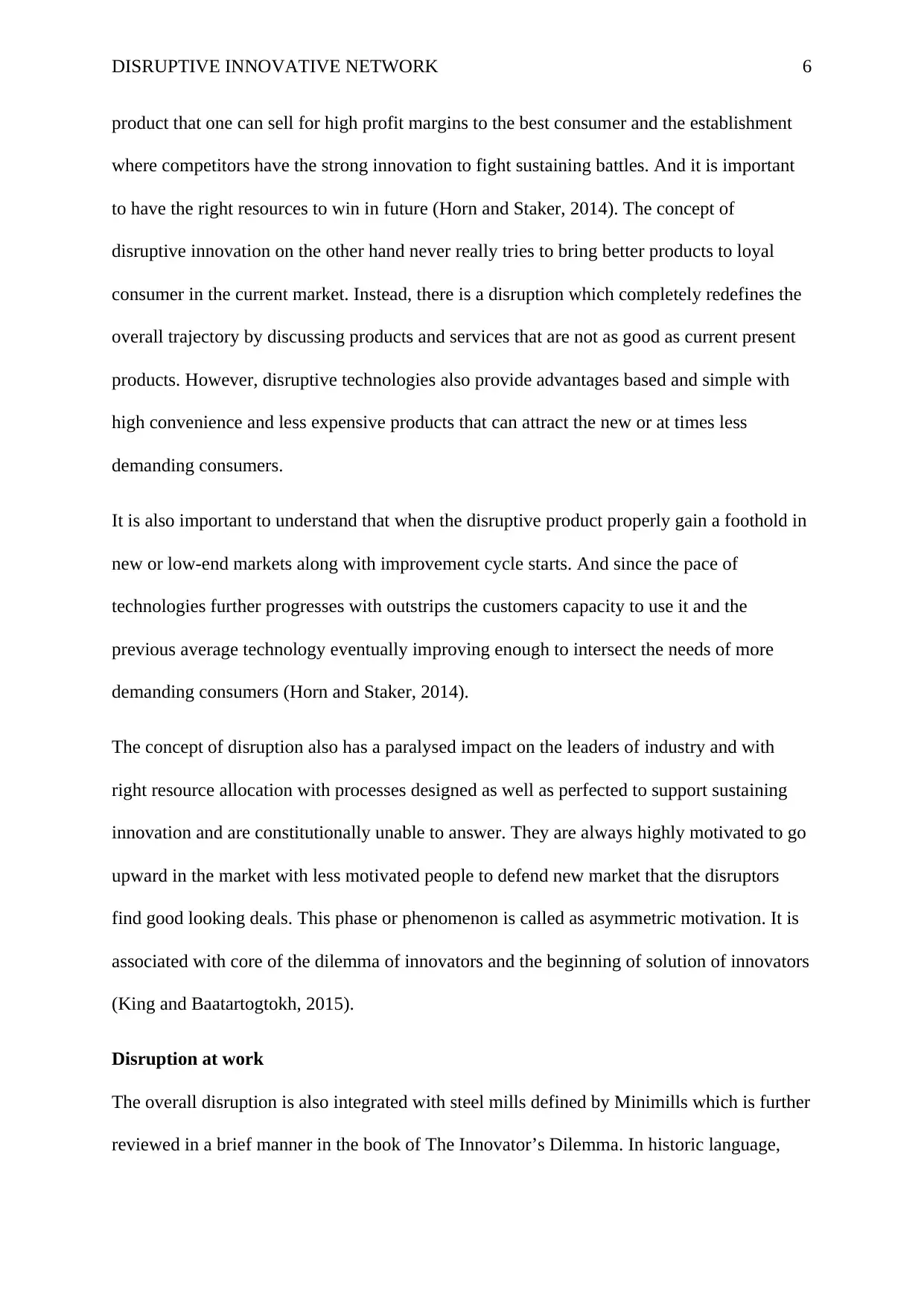
DISRUPTIVE INNOVATIVE NETWORK 6
product that one can sell for high profit margins to the best consumer and the establishment
where competitors have the strong innovation to fight sustaining battles. And it is important
to have the right resources to win in future (Horn and Staker, 2014). The concept of
disruptive innovation on the other hand never really tries to bring better products to loyal
consumer in the current market. Instead, there is a disruption which completely redefines the
overall trajectory by discussing products and services that are not as good as current present
products. However, disruptive technologies also provide advantages based and simple with
high convenience and less expensive products that can attract the new or at times less
demanding consumers.
It is also important to understand that when the disruptive product properly gain a foothold in
new or low-end markets along with improvement cycle starts. And since the pace of
technologies further progresses with outstrips the customers capacity to use it and the
previous average technology eventually improving enough to intersect the needs of more
demanding consumers (Horn and Staker, 2014).
The concept of disruption also has a paralysed impact on the leaders of industry and with
right resource allocation with processes designed as well as perfected to support sustaining
innovation and are constitutionally unable to answer. They are always highly motivated to go
upward in the market with less motivated people to defend new market that the disruptors
find good looking deals. This phase or phenomenon is called as asymmetric motivation. It is
associated with core of the dilemma of innovators and the beginning of solution of innovators
(King and Baatartogtokh, 2015).
Disruption at work
The overall disruption is also integrated with steel mills defined by Minimills which is further
reviewed in a brief manner in the book of The Innovator’s Dilemma. In historic language,
product that one can sell for high profit margins to the best consumer and the establishment
where competitors have the strong innovation to fight sustaining battles. And it is important
to have the right resources to win in future (Horn and Staker, 2014). The concept of
disruptive innovation on the other hand never really tries to bring better products to loyal
consumer in the current market. Instead, there is a disruption which completely redefines the
overall trajectory by discussing products and services that are not as good as current present
products. However, disruptive technologies also provide advantages based and simple with
high convenience and less expensive products that can attract the new or at times less
demanding consumers.
It is also important to understand that when the disruptive product properly gain a foothold in
new or low-end markets along with improvement cycle starts. And since the pace of
technologies further progresses with outstrips the customers capacity to use it and the
previous average technology eventually improving enough to intersect the needs of more
demanding consumers (Horn and Staker, 2014).
The concept of disruption also has a paralysed impact on the leaders of industry and with
right resource allocation with processes designed as well as perfected to support sustaining
innovation and are constitutionally unable to answer. They are always highly motivated to go
upward in the market with less motivated people to defend new market that the disruptors
find good looking deals. This phase or phenomenon is called as asymmetric motivation. It is
associated with core of the dilemma of innovators and the beginning of solution of innovators
(King and Baatartogtokh, 2015).
Disruption at work
The overall disruption is also integrated with steel mills defined by Minimills which is further
reviewed in a brief manner in the book of The Innovator’s Dilemma. In historic language,
⊘ This is a preview!⊘
Do you want full access?
Subscribe today to unlock all pages.

Trusted by 1+ million students worldwide
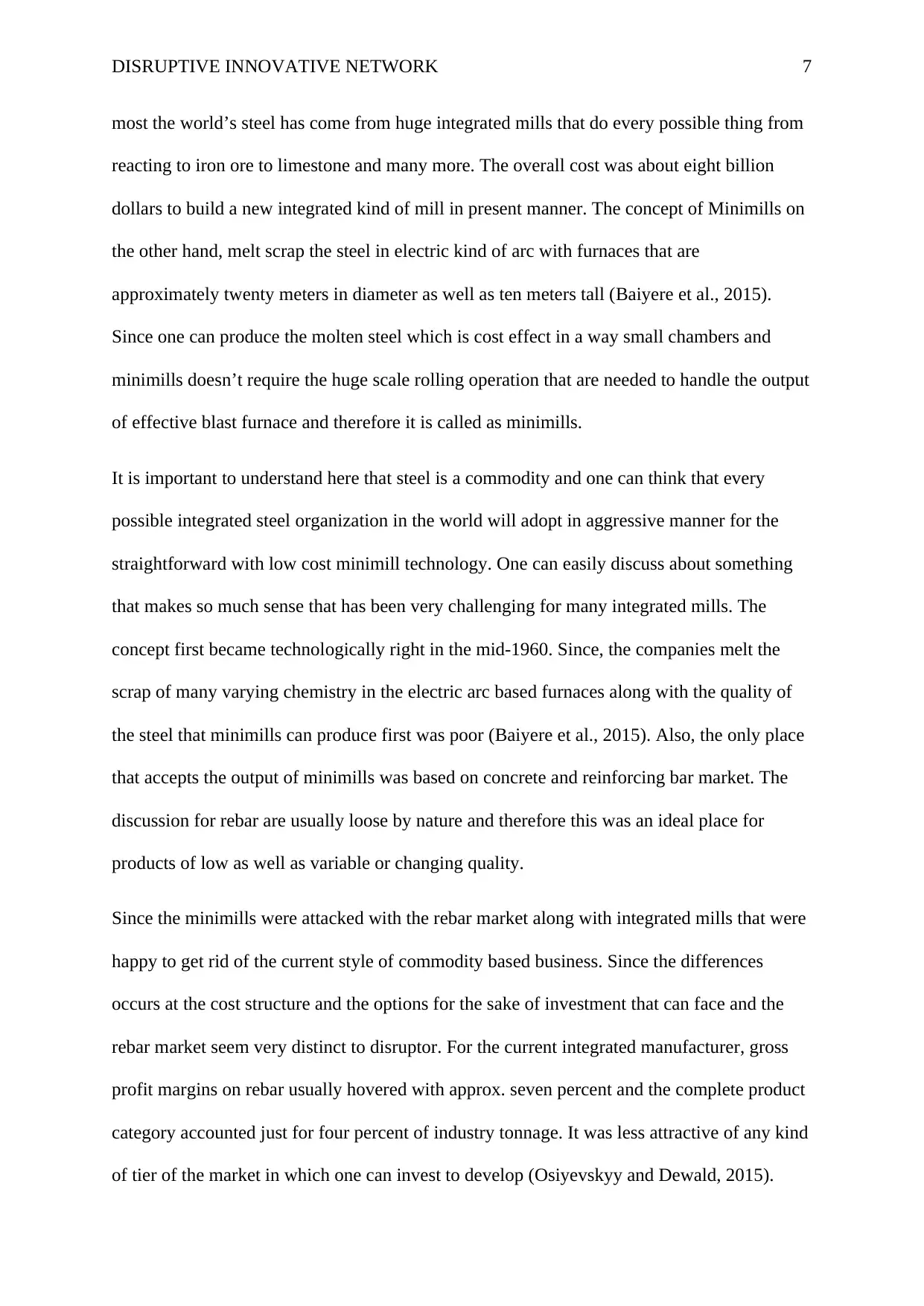
DISRUPTIVE INNOVATIVE NETWORK 7
most the world’s steel has come from huge integrated mills that do every possible thing from
reacting to iron ore to limestone and many more. The overall cost was about eight billion
dollars to build a new integrated kind of mill in present manner. The concept of Minimills on
the other hand, melt scrap the steel in electric kind of arc with furnaces that are
approximately twenty meters in diameter as well as ten meters tall (Baiyere et al., 2015).
Since one can produce the molten steel which is cost effect in a way small chambers and
minimills doesn’t require the huge scale rolling operation that are needed to handle the output
of effective blast furnace and therefore it is called as minimills.
It is important to understand here that steel is a commodity and one can think that every
possible integrated steel organization in the world will adopt in aggressive manner for the
straightforward with low cost minimill technology. One can easily discuss about something
that makes so much sense that has been very challenging for many integrated mills. The
concept first became technologically right in the mid-1960. Since, the companies melt the
scrap of many varying chemistry in the electric arc based furnaces along with the quality of
the steel that minimills can produce first was poor (Baiyere et al., 2015). Also, the only place
that accepts the output of minimills was based on concrete and reinforcing bar market. The
discussion for rebar are usually loose by nature and therefore this was an ideal place for
products of low as well as variable or changing quality.
Since the minimills were attacked with the rebar market along with integrated mills that were
happy to get rid of the current style of commodity based business. Since the differences
occurs at the cost structure and the options for the sake of investment that can face and the
rebar market seem very distinct to disruptor. For the current integrated manufacturer, gross
profit margins on rebar usually hovered with approx. seven percent and the complete product
category accounted just for four percent of industry tonnage. It was less attractive of any kind
of tier of the market in which one can invest to develop (Osiyevskyy and Dewald, 2015).
most the world’s steel has come from huge integrated mills that do every possible thing from
reacting to iron ore to limestone and many more. The overall cost was about eight billion
dollars to build a new integrated kind of mill in present manner. The concept of Minimills on
the other hand, melt scrap the steel in electric kind of arc with furnaces that are
approximately twenty meters in diameter as well as ten meters tall (Baiyere et al., 2015).
Since one can produce the molten steel which is cost effect in a way small chambers and
minimills doesn’t require the huge scale rolling operation that are needed to handle the output
of effective blast furnace and therefore it is called as minimills.
It is important to understand here that steel is a commodity and one can think that every
possible integrated steel organization in the world will adopt in aggressive manner for the
straightforward with low cost minimill technology. One can easily discuss about something
that makes so much sense that has been very challenging for many integrated mills. The
concept first became technologically right in the mid-1960. Since, the companies melt the
scrap of many varying chemistry in the electric arc based furnaces along with the quality of
the steel that minimills can produce first was poor (Baiyere et al., 2015). Also, the only place
that accepts the output of minimills was based on concrete and reinforcing bar market. The
discussion for rebar are usually loose by nature and therefore this was an ideal place for
products of low as well as variable or changing quality.
Since the minimills were attacked with the rebar market along with integrated mills that were
happy to get rid of the current style of commodity based business. Since the differences
occurs at the cost structure and the options for the sake of investment that can face and the
rebar market seem very distinct to disruptor. For the current integrated manufacturer, gross
profit margins on rebar usually hovered with approx. seven percent and the complete product
category accounted just for four percent of industry tonnage. It was less attractive of any kind
of tier of the market in which one can invest to develop (Osiyevskyy and Dewald, 2015).
Paraphrase This Document
Need a fresh take? Get an instant paraphrase of this document with our AI Paraphraser

DISRUPTIVE INNOVATIVE NETWORK 8
Therefore, as the establishment of minimills as a foothold in the market along with integrated
mills that were reconfigured the rebar lines to make highly profitable products. On the other
hand, there was twenty percent of cost based advantage and the minimills have further
enjoyed the attractive profits of competition which is completely against the current
integrated mills for rebar until 1979 specifically when minimills finally succeed in driving
with last integrated mill out of the rebar set of market. As per the past record, pricing
statistics shows that prices is based on rebar then collapsing by more than twenty percent. In
minimill can also compete against the prohibitive cost and integrated mills.
Conclusion
The concept of disruptive innovation will keep expanding as well as refining the basic theory
of disruptive innovation along with much work that lies in future. For instance, there are
number of universally impactful answers to many disruptive threats that also remain
completely elusive. The current set of belief in the system of companies should develop a
separate set of division that functions under the protection of many senior leadership to
rightly explore a new kind of disruptive model (Reinhardt, 2013). There is time, the method
works and there is time when it doesn’t. In specific cases, a failed response to disruptive
threat cannot be part of lack of clarity with insufficient executive level attention and wrong
financial investments. Such issues that come up with an incumbent and an entrant level have
yet to be completely specified and how best to meet the issues is still needs to be discovered.
The theory of disruption does not completely explain everything about the concept of
disruptive innovation. It is important to understand that there far too many cases that are in
play and each element of will help in rewarding for further studies (Parry and Kawakami,
2017).
Therefore, as the establishment of minimills as a foothold in the market along with integrated
mills that were reconfigured the rebar lines to make highly profitable products. On the other
hand, there was twenty percent of cost based advantage and the minimills have further
enjoyed the attractive profits of competition which is completely against the current
integrated mills for rebar until 1979 specifically when minimills finally succeed in driving
with last integrated mill out of the rebar set of market. As per the past record, pricing
statistics shows that prices is based on rebar then collapsing by more than twenty percent. In
minimill can also compete against the prohibitive cost and integrated mills.
Conclusion
The concept of disruptive innovation will keep expanding as well as refining the basic theory
of disruptive innovation along with much work that lies in future. For instance, there are
number of universally impactful answers to many disruptive threats that also remain
completely elusive. The current set of belief in the system of companies should develop a
separate set of division that functions under the protection of many senior leadership to
rightly explore a new kind of disruptive model (Reinhardt, 2013). There is time, the method
works and there is time when it doesn’t. In specific cases, a failed response to disruptive
threat cannot be part of lack of clarity with insufficient executive level attention and wrong
financial investments. Such issues that come up with an incumbent and an entrant level have
yet to be completely specified and how best to meet the issues is still needs to be discovered.
The theory of disruption does not completely explain everything about the concept of
disruptive innovation. It is important to understand that there far too many cases that are in
play and each element of will help in rewarding for further studies (Parry and Kawakami,
2017).
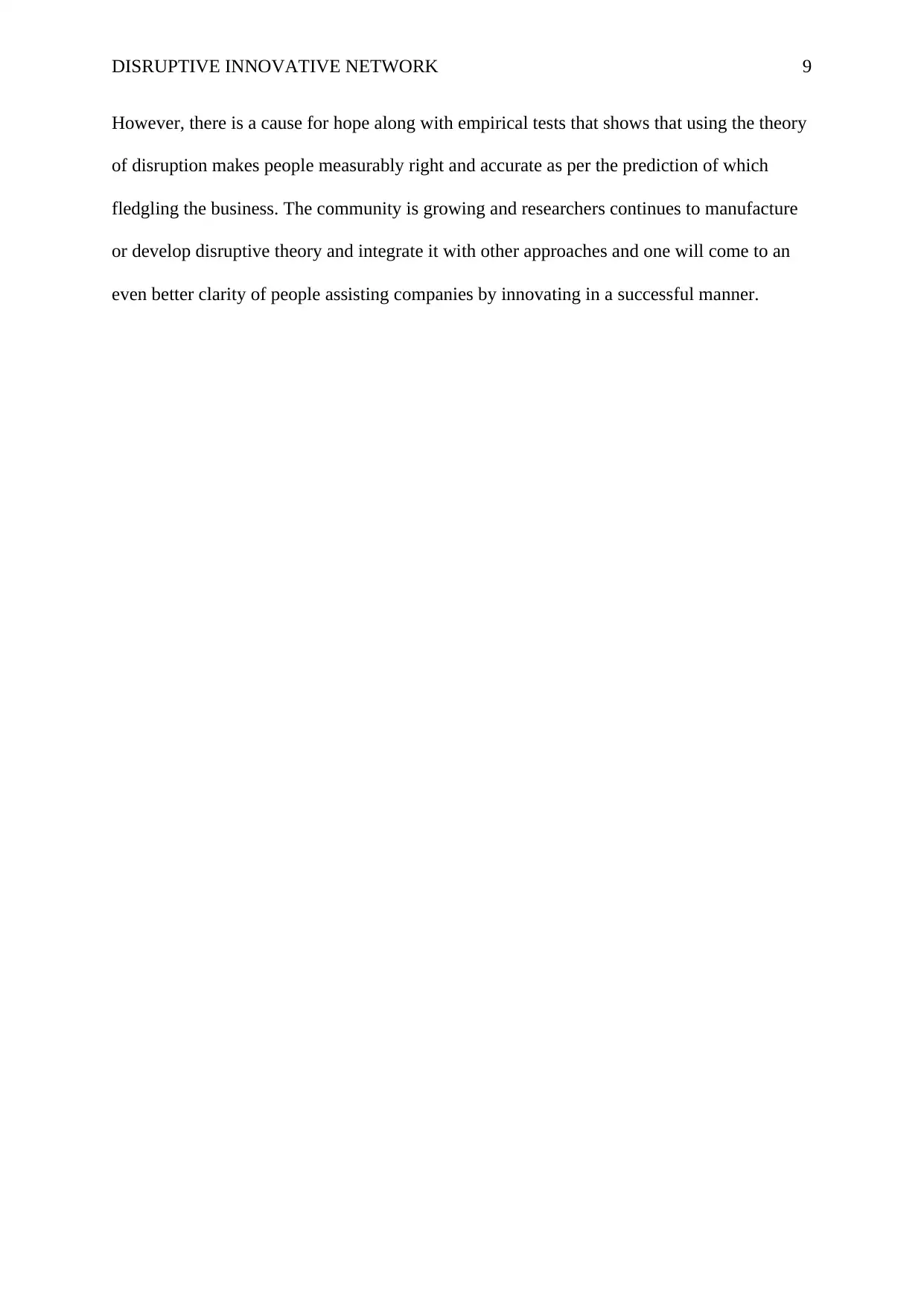
DISRUPTIVE INNOVATIVE NETWORK 9
However, there is a cause for hope along with empirical tests that shows that using the theory
of disruption makes people measurably right and accurate as per the prediction of which
fledgling the business. The community is growing and researchers continues to manufacture
or develop disruptive theory and integrate it with other approaches and one will come to an
even better clarity of people assisting companies by innovating in a successful manner.
However, there is a cause for hope along with empirical tests that shows that using the theory
of disruption makes people measurably right and accurate as per the prediction of which
fledgling the business. The community is growing and researchers continues to manufacture
or develop disruptive theory and integrate it with other approaches and one will come to an
even better clarity of people assisting companies by innovating in a successful manner.
⊘ This is a preview!⊘
Do you want full access?
Subscribe today to unlock all pages.

Trusted by 1+ million students worldwide
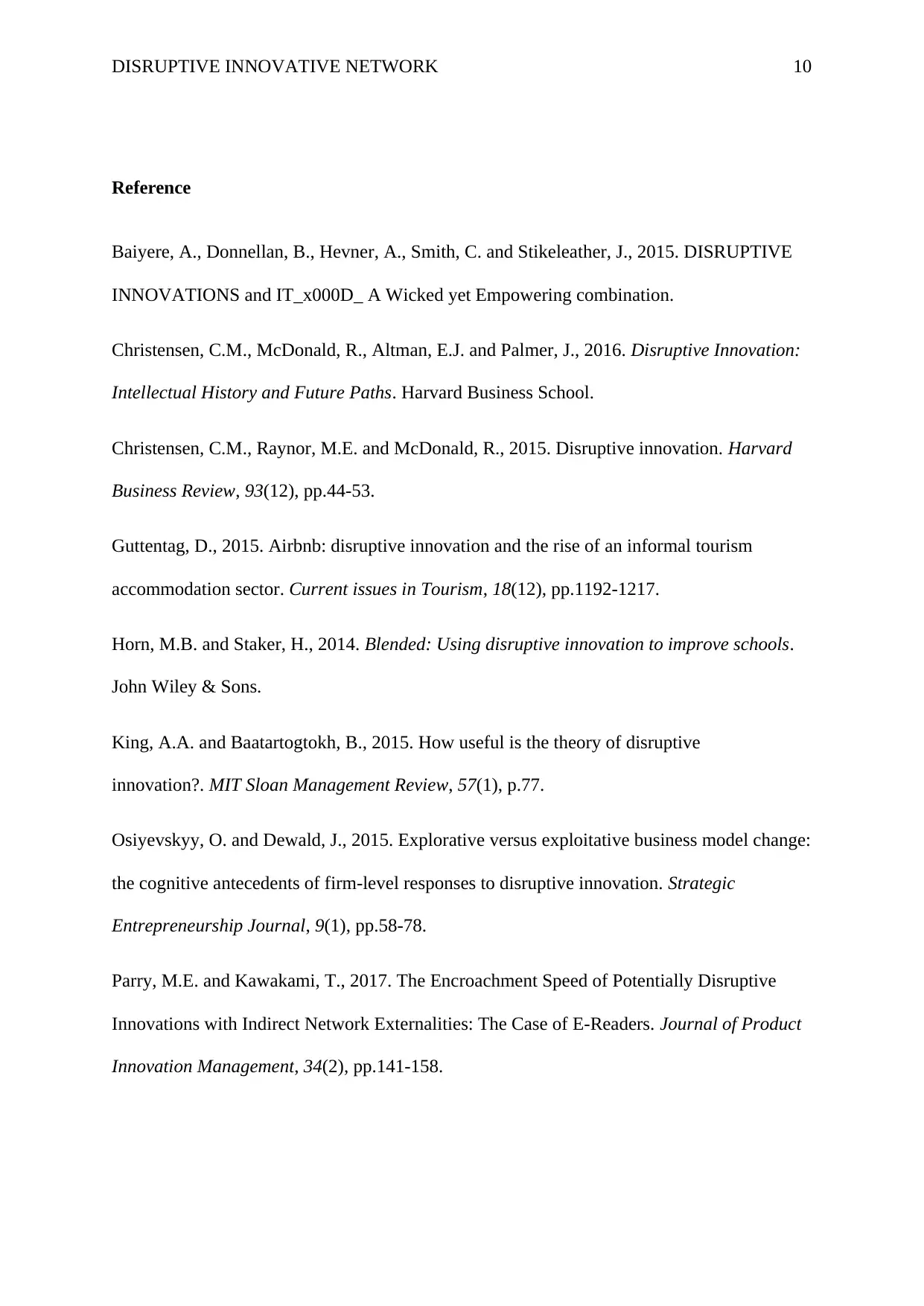
DISRUPTIVE INNOVATIVE NETWORK 10
Reference
Baiyere, A., Donnellan, B., Hevner, A., Smith, C. and Stikeleather, J., 2015. DISRUPTIVE
INNOVATIONS and IT_x000D_ A Wicked yet Empowering combination.
Christensen, C.M., McDonald, R., Altman, E.J. and Palmer, J., 2016. Disruptive Innovation:
Intellectual History and Future Paths. Harvard Business School.
Christensen, C.M., Raynor, M.E. and McDonald, R., 2015. Disruptive innovation. Harvard
Business Review, 93(12), pp.44-53.
Guttentag, D., 2015. Airbnb: disruptive innovation and the rise of an informal tourism
accommodation sector. Current issues in Tourism, 18(12), pp.1192-1217.
Horn, M.B. and Staker, H., 2014. Blended: Using disruptive innovation to improve schools.
John Wiley & Sons.
King, A.A. and Baatartogtokh, B., 2015. How useful is the theory of disruptive
innovation?. MIT Sloan Management Review, 57(1), p.77.
Osiyevskyy, O. and Dewald, J., 2015. Explorative versus exploitative business model change:
the cognitive antecedents of firm‐level responses to disruptive innovation. Strategic
Entrepreneurship Journal, 9(1), pp.58-78.
Parry, M.E. and Kawakami, T., 2017. The Encroachment Speed of Potentially Disruptive
Innovations with Indirect Network Externalities: The Case of E‐Readers. Journal of Product
Innovation Management, 34(2), pp.141-158.
Reference
Baiyere, A., Donnellan, B., Hevner, A., Smith, C. and Stikeleather, J., 2015. DISRUPTIVE
INNOVATIONS and IT_x000D_ A Wicked yet Empowering combination.
Christensen, C.M., McDonald, R., Altman, E.J. and Palmer, J., 2016. Disruptive Innovation:
Intellectual History and Future Paths. Harvard Business School.
Christensen, C.M., Raynor, M.E. and McDonald, R., 2015. Disruptive innovation. Harvard
Business Review, 93(12), pp.44-53.
Guttentag, D., 2015. Airbnb: disruptive innovation and the rise of an informal tourism
accommodation sector. Current issues in Tourism, 18(12), pp.1192-1217.
Horn, M.B. and Staker, H., 2014. Blended: Using disruptive innovation to improve schools.
John Wiley & Sons.
King, A.A. and Baatartogtokh, B., 2015. How useful is the theory of disruptive
innovation?. MIT Sloan Management Review, 57(1), p.77.
Osiyevskyy, O. and Dewald, J., 2015. Explorative versus exploitative business model change:
the cognitive antecedents of firm‐level responses to disruptive innovation. Strategic
Entrepreneurship Journal, 9(1), pp.58-78.
Parry, M.E. and Kawakami, T., 2017. The Encroachment Speed of Potentially Disruptive
Innovations with Indirect Network Externalities: The Case of E‐Readers. Journal of Product
Innovation Management, 34(2), pp.141-158.
Paraphrase This Document
Need a fresh take? Get an instant paraphrase of this document with our AI Paraphraser
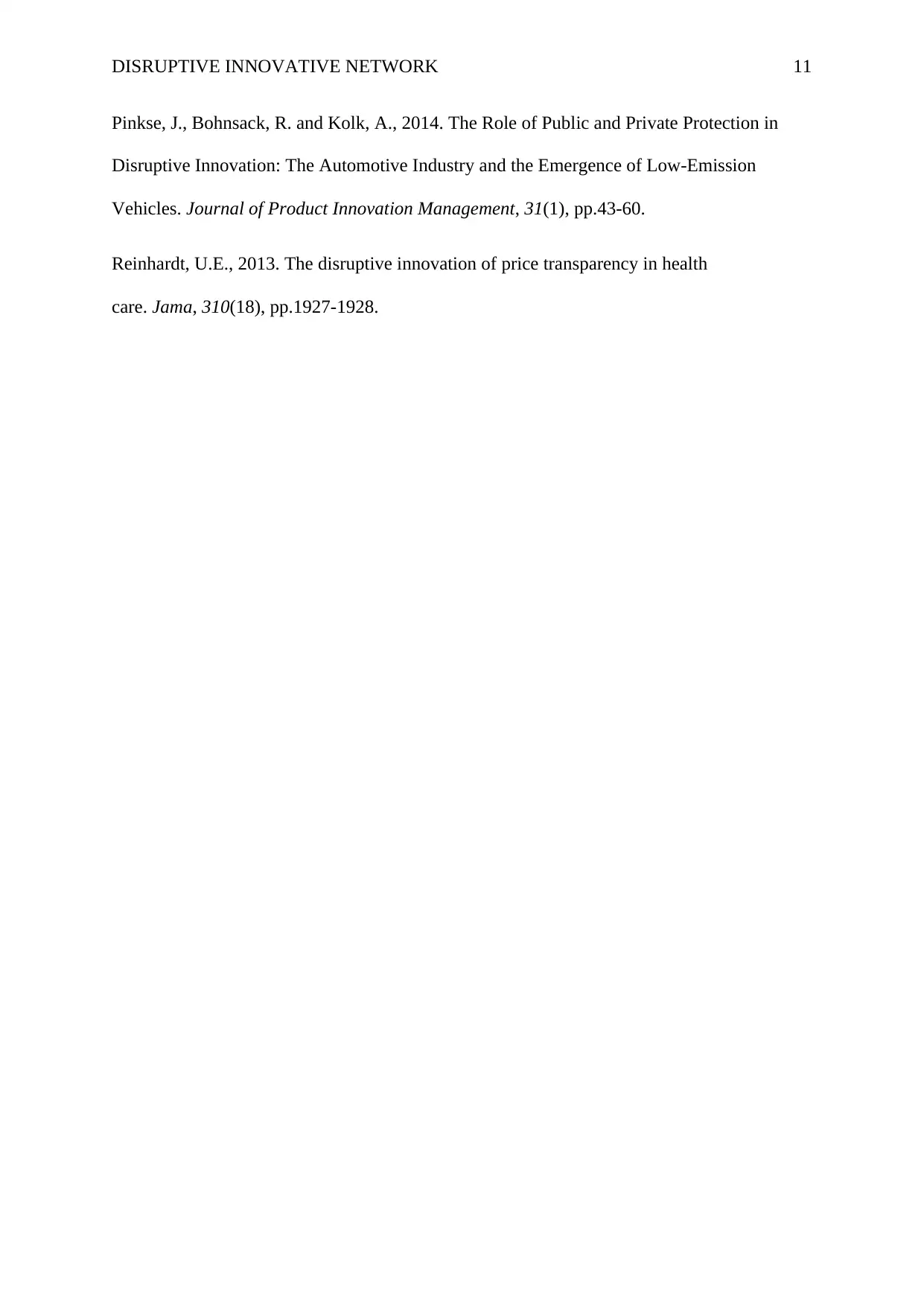
DISRUPTIVE INNOVATIVE NETWORK 11
Pinkse, J., Bohnsack, R. and Kolk, A., 2014. The Role of Public and Private Protection in
Disruptive Innovation: The Automotive Industry and the Emergence of Low‐Emission
Vehicles. Journal of Product Innovation Management, 31(1), pp.43-60.
Reinhardt, U.E., 2013. The disruptive innovation of price transparency in health
care. Jama, 310(18), pp.1927-1928.
Pinkse, J., Bohnsack, R. and Kolk, A., 2014. The Role of Public and Private Protection in
Disruptive Innovation: The Automotive Industry and the Emergence of Low‐Emission
Vehicles. Journal of Product Innovation Management, 31(1), pp.43-60.
Reinhardt, U.E., 2013. The disruptive innovation of price transparency in health
care. Jama, 310(18), pp.1927-1928.
1 out of 11
Related Documents
Your All-in-One AI-Powered Toolkit for Academic Success.
+13062052269
info@desklib.com
Available 24*7 on WhatsApp / Email
![[object Object]](/_next/static/media/star-bottom.7253800d.svg)
Unlock your academic potential
Copyright © 2020–2025 A2Z Services. All Rights Reserved. Developed and managed by ZUCOL.





